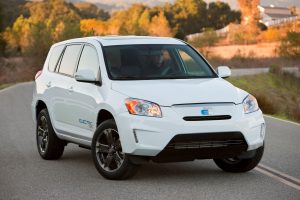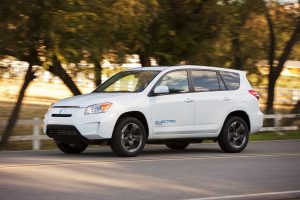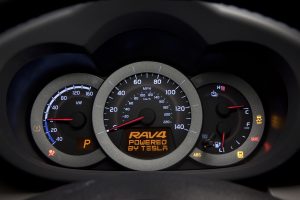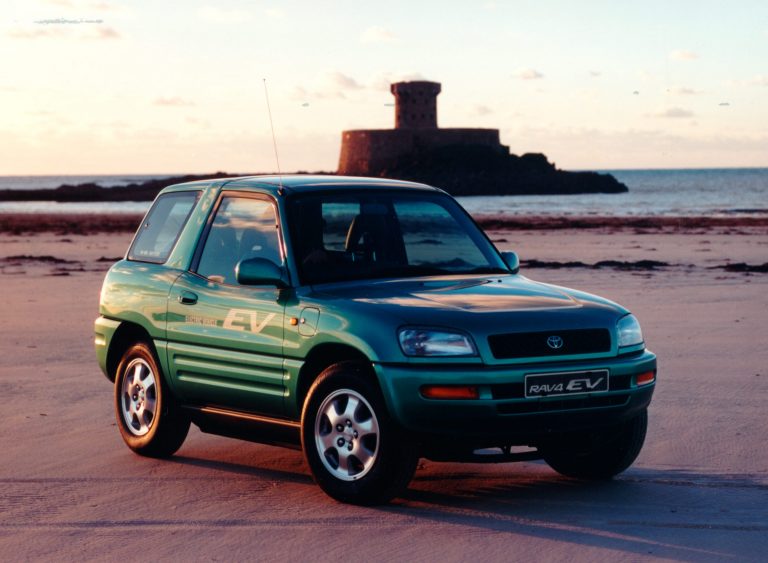Tesla-Toyota ‘RAV4 EV’ Concept Debuts at LA Show
Real-world cruising range target of 100 miles
The Toyota ‘RAV4 EV’ concept, an electric vehicle jointly developed with Tesla, has made its debut at the Los Angeles Auto Show.
A total of 35 vehicles will be built for a demonstration and evaluation program through 2011, with the introduction of a final production model in the US in 2012. The final production vehicle will have a target range of 100 miles in actual road driving patterns, in a wide range of climates and conditions.
The RAV4 EV concept is based on the current Toyota RAV4 compact SUV body and fitted with a Tesla electric powertrain.
“When we decided to work together on the RAV4 EV, President Akio Toyoda wanted to adopt a new development model that incorporated Tesla’s streamlined, quick-action approach,” said Jim Lentz, president and chief operating officer, Toyota Motor Sales USA.
“The result was a hybrid – a new decision and approval process and a development style that our engineers refer to as “fast and flexible.”
Led by the Toyota Motor Engineering and Manufacturing North America (TEMA) Technical Centre in Michigan, the new development model helped reduce development time without compromising product quality. The team has accomplished this by approaching the project as they would a typical mid-cycle “major-minor” product change. Specifically, midway through a generation, the team began with a fully engineered current-generation RAV4, to which was added a major powertrain option, along with minor feature and cosmetic changes.
Tesla was responsible for building and supplying the battery, as well as other related parts, that met specific Toyota engineering specifications in performance, quality and durability. Toyota was responsible for development and manufacturing leadership and the seamless integration of the powertrain.
“From the beginning, the customer experience has been the focus,” said Lentz. “In other words, how do we deliver an unconventional product to mainstream customers that is compelling and affordable and that offers an acceptable level of daily convenience.”
A large part of the team’s focus on the customer experience targeted driveability. In this case, the end goal is a vehicle with driveability characteristics as close to the conventional RAV4 as possible. For example, the demonstration vehicle weighs approximately 100kg more than the current RAV4 V6 (US model) yet it will accelerate from zero to sixty nearly as quickly.
This added weight factor required significant retuning of major components and a prioritized focus on weight distribution. Not only were suspension and steering modified significantly, major components needed to be relocated to better balance the increased mass of the battery pack.
The demonstration vehicle Toyota is currently testing is powered by a lithium metal oxide battery with useable output rated in the mid-30kwh range. However, many decisions regarding both the product, as well as the business model, have not been finalised. Battery size and final output ratings, as well as pricing and volume projections of the vehicle Toyota plans to bring to market in 2012, have not been decided.
As for a final assembly location, Toyota is considering many options and combinations. The basic vehicle will continue to be built at its Canadian production facility in Woodstock, Ontario. Tesla will build the battery and related parts and components at its new facility in Palo Alto, Calif. The method and installation location of the Tesla components into the vehicle is being discussed.
The RAV4 EV received several distinct exterior styling changes including a new front bumper, grille, fog lamps and head lamps. New EV badging and the custom “mutually exclusive” paint colour, completed the transformation. The interior received custom seat trim, multimedia dash displays, push-button shifter and dashboard meters. No cargo space was lost in the RAV4’s conversion to an electric powertrain.
In 1997, Toyota brought to market the first-generation RAV4 EV in response to the California zero emission vehicle (ZEV) mandate and was the first manufacturer to meet the mandate’s Memo of Agreement on volume sales. Powered by a nickel-metal hydride battery pack, the vehicle had a range of between 80-110 miles on a single charge. From model year 1998 to model year 2003, only 1,484 vehicles were sold or leased in the U.S. 746 first-generation RAV4 EVs are still on the road (www.toyotarav4ev.com).
“A price and convenience proved to be critical success factors and they remain so today,” said Lentz. “But much has changed in the last few years. Most importantly, the growing level of awareness that sustainable mobility will come at a cost that must be shared by the automakers, government and the consumer.”
RAV4 EV is a further example of Toyota’s efforts to reduce the use of fossil fuels and cut CO2 emissions by developing more efficient and alternative powertrain technologies. It has led the industry in the development of hybrid petrol-electric systems, as deployed in Prius, Auris hybrid and other models in markets worldwide.
ENDS













